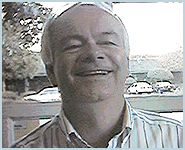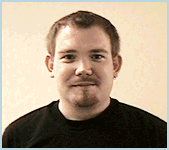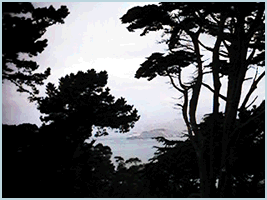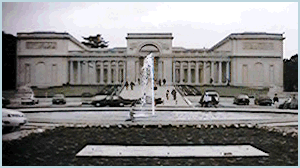
West Portal Reflections #11, October 26, 1997
West Portal Director of the MSU Communication Technology Laboratory
West Portal Reflections document my experiences as I try to open a portal to Northern California for Michigan State University. They are targeted to my teams in the Comm Tech Lab and Virtual University, to my close colleagues and bosses throughout Michigan State University, and to close friends and family. These pages serve as ethnographic documentation of my participant-observation research on TeleRelating ("using technology to sustain and enhance close personal relationships"). The contents mix professional and personal life because I am reaching out 2500 miles to people I care about and work with. I hope my reflections help you to keep me in your hearts and make San Francisco a place that is yours. Thanks for journeying with me as I think, learn and experiment.
Telecommuting conference and ViaTV
My TeleRelating in Cyberspace Talk
Tamiko Thiel, New Media Artist
Virtual University DMAT Course Opportunity
This time, Jamie Dinkelacker and I managed to meet at the same Hobbies branch in Palo Alto and have dinner together. Jamie is a former MSU Com Department Ph.D. and now a Learning Architect at Netscape.

I asked him we could help Netscape will survive Microsoft's attempts to destroy it. He suggested three things I could do to help: Hit the Netscape home page twice a day to keep its ratings high. Do not use Word or Microsoft Office. Don't upgrade to Windows '95 or Windows '98 -- Netscape works fine on Windows 3.1.
Netscape 5.0, coming this winter, will be a complete rewrite in Java Beans. It will be component based and extensible. He suggests we watch for xml and rdf as up and coming preferred alternatives to html.
Netscape views academics as people always looking for free stuff. They are turning to the corporate world and to intranets to make a living. So, no, I did not walk away with a grant for MSU from Netscape...
Chris White of WebTV (www.webtv.net) demonstrated the current service and beta versions of the next version at the BayCHI meeting. I realize I am an easy sell for technology, but I drove home from Palo Alto wanting one.
He started by saying with Microsoft's purchase of the company, they were no longer working out of Phil Goldman's garage. The crowded auditorium hissed at the mention of Microsoft. Fumbling for approval, he explained that WebTV was started by three people from Apple. The crowd hissed again. He admitted that many people on the staff now formerly worked at Intel and HP. More hisses. He gave up.
As one with a doctorate in Mass Media, having studied how people watch TV and hypothesized about futuristic interfaces that could make TV viewing both more intelligent and more purposeful, I was excited to see demonstrations of broadcast TV used in conjunction with the WebTV service. Broadcast TV is a layer -- it can appear full screen, as picture in picture, and (I think) overlayed. TV guide is online and interactive, allowing intelligent zapping and systematic program choice. For various programs such as football, support pages exist for reading and searching while watching the program. Bob Matson, I think we could find interesting ways to watch Star Trek together if we became developers for the program.
WebTV has interesting implications for education. Patrick Dickson contemplates increased use of public television in teaching. Web TV could enhance PTV programs and provide custom resources as well as access to the WWW of resources. What WebTV offers that WWW does not is the intimate integration with broadcast TV.
Anyway, I did not expect to like the presentation or the service. But I was impressed.
Jacob Nielsen, Distinguished Scientist at Sun Microsystems, talked about CONTENT USABILITY OF WEB SITES at the Computer Human Interaction User's Group. He maintains a web site of design advice, http://www.useit.com/.
Nielsen describes the web as an "impatient" medium. Four fifths of web users SCAN pages. Only sixteen percent read word for word. People can be on the page with the information they are looking for and never see the info. By the year 2000, $100,000,000 in productivity time will have been wasted due to navigation problems.
He recommends
More quotes:
All web sites are confused. Internally focussed but externally exhibitted. Think of your audience. Hard to maintain consistency across as few as 10 pages. Impossible with Sun's 2 million.
Computer reading is 25% slower than paper reading.
Web is a user-paced medium.
Information foraging -- attention economics. Every web page is in competition with millions of other pages. The other pages are so temptingly close.
Outbound links enhance credibility, the equivalent of providing supporting evidence.
Nielsen's best-selling books include Multimedia and Hypertext: The Internet and Beyond (AP Professional 1995), Usability Engineering (paperback edition published by AP Professional 1994) and Usability Inspection Methods (John Wiley & Sons 1994).
For 2 days last week, a small corner of Moscone Center in downtown SF was occupied by the Telecommuting Convention. Every other time I have attended a conference at Moscone Center, I spent one full day traveling from East Lansing and one full day traveling back. It was a kick to get on the muni at 2pm, walk to the conference center, spend an hour and half there, and Muni home.
When I chatted with exhibitors and mentioned that I was telecommuting from SF to East Lansing, they seemed shocked. Apparently most telecommuters live rather closer to the office and many telecommute one or two days per week. Mostly they were exhibiting telephones.
One technology stood out -- I expect we will adopt it for the Comm Tech Lab, VU, DMAT, West Portal, and perhaps, the MIND Lab: ViaTV (www.viatv.com). Via TV is a box to connect to voice phone lines and a television set. Versions come with built in camera or with video in. ViaTV has the best quality over-phone-line video signal I have seen. And because they provide video out signals, it can be fed to a large screen projector or to a regular TV set. We can use it in conjunction with the US Robotics speakerphones. Good for teaching.
Cost estimates are under $300 for the unit without built in camera, and $350 with a built in camera. Much more flexibility if you use your own camera, or VCR, or computer to have a choice of video inputs.
I still hate the idea of sending video of my face. And I still do not have a video camera. But probably ViaTV is an important tool for remote teaching and telerelating.
My telerelating talk at the Earth to Avatars conference began at 9am on the morning of the 3 hour sabbotage power outage that turned off power to half the city and, by halting electronic streetcars, resulted in the worst parking nightmare downtown since the Peta Loma earthquake. I spoke to an audience of 4, as attendees struggled to get to the conference. However, I will use the talk in other contexts, including approaching Sun and Xerox Parc. Preparing the talk helped me get a perspective on what we have discovered about telerelating so far this fall.
The 26 web page paper is password protected. If you are interested in viewing the pages, email me and I will arrange for you to access them. For now, I am not ready to make the talk available to the world in general, as it will feed into my telerelating book and articles.

Here's my panel. The man next to me is Anthony Lloyd from BioControl Systems, Inc makers of BioMuse to use biorhythms and muscle sensors to control interactive experiences for disabled people. Tamiko Thiel, designer of the StarBright World virtual reality playspace for children's hospitals. Tom Riess has Parkinson's Disease and develops head mounted display technologies to facilitate walking. Galen Brandt singer and cyberperformer who has appeared as a Tiny Dancer in Myron Krueger's VIDEOPLACE installations, a CyberPrincess in the Vivid Group's Mandala environments, and as the Body Electric with the BioMuse and BodySynth biosignal-to-MIDI biocontrollers.
Tamiko Thiel, New Media Artist

I had the pleasure of meeting Tamiko Thiel (http://mission.base.com/tamiko/), a New Media Artist and female geek. Our perspectives on designing experiences were so similar the panel organizer arranged for us to talk in advance and differentiate our speeches. Differences were plentiful, but like mindedness is fun. Tamiko designed a virtual reality playspace for seriously ill children, Starbright World. She lives in the Mission District, telecommutes to work though locally, is married to the SYSOP for Black Sun Interactive (now Blaxum), and will be speaking and exhibiting at Chik Tek in San Jose next weekend.
The conference mixed off the wall bizarre with mainstream innovation; artistic-cultural dialogs with esoteric academia; and pragmatic business issues in virtual communities.
My interest in avatar and virtual world technologies is their application to telerelating between close friends, family and colleagues. Most virtual communities are populated by strangers who meet online for the first time and hold relatively inane and shallow conversations. At one session, the head of a virtual world company in operation for five years at last admitted that his worlds are boring and people have nothing to say to each other. Now they are trying to create communities.
Wednesday night's session began with large screen projection of OnLive Traveler, a 3D avatar cyberspace with 3D audio and text chat featuring head-only 3D avatars with facial expressions including smiling and blinking. A Barbie-like head floated staring at the screen and blinking. Conference organizer Bruce Damer spoke into his microphone, asking her name. The mic did not work, there was no response. He resorted to typing in the text chat mode, and in a moment, she said "Hi, I'm Pam." He typed "where are you?" She said "Indiana." He typed "800 people at a conference are watching you from California." She blinked and continued to float. The talk show conference session (in person) began.
At the end of the talk show, a singer came onstage and sang a piece called "Transformation." A cat avatar lip synched to her microphone sang to the Onlive virtual world, while lots of floating face avatars floated, blinked, and listened. (The singer, Galen, is also the organizer of my session on Cyberspace and Healing.)
AlphaWorld has more than 200,000 citizens. When the parent company went out of business, citizens organized to purchase the software and continue the world themselves. A sociologist and anthropologist's dream, virtual communities like this one provide rich research environment for studying virtual human behavior. Virtual World companies often hire anthropologists to advise them on community building, and to act as Host, Gods or Wizards in the virtual worlds.
I doubted, watching presenters at the "Your Avatar, Your Identity 2" session demonstrate their AI conversation software by typing "I want you to give me head" into the chat window below a goddess avatar they had built with 8 breasts and 6 rotating arms, that Sheldon at his Mathematics conference in Wisconsin was attending similar sessions.
Bruce Damers new book, Avatars, and his companion web site at http://www.digitalspace.com/avatars/ document state of the art in avatar technology and practice. I feel betrayed by Apple that NONE of the worlds other than the Palace run on Macintosh. When my DEL arrives, I can actually experience these technologies.
At Earth to Avatars, I met Alex Lightman from LA, www.hollyworlds.com/
They create VRML worlds based on science fiction movies, including: Xena, Spawn, the Fifth Element and Lost in Space. He is teaching a course in creating VRML sci fi worlds at UCLA in January. He offered to provide me with videotapes of the sessions and to work with me to create a web site for MSU virtual university, to use in DMAT classes and to offer worldwide as an online conference.
This proposition from a ten minute conversation...
I think the intellectual property issues will be intense, given a UCLA course, an entrepreneur teacher, Hollywood, and the sci fi authors he plans to involve. Still, it would be a sexy offering with likely wide appeal. And it would be fun.
DMAT and CCAS and VU need to decide whether we are interested in launching a VU DMAT certificate program and whether we are ready to start up our series of nine on credit mini-offerings. I spoke with Frank Biocca today, and he sounded interested. Look for reactions from Dean Jim and Chair Tom and Vice Provost Paul.
Todd Shaffer took TC 446 at MSU years ago because the business class he wanted to get into was full, and Greg Newton suggested he take the class. Today he works for Cosmos and SGI developing and marketing Cosmos virtual worlds. His informative home page is: http://reality.sgi.com/shafer_mfg/Home/homeframe.html Todd agreed to be an Industry Mentor for DMAT students, and to virtually teach a session of Advanced Hypermedia Concepts this spring. If SGI still exists when the stock market crash dust settles.

He demonstrated Paragraph's Home Space Builder on PC. The PC version is much more powerful than the Mac version I use. How annoying.
Am currently up to my eyeballs in marketing efforts for the CTL and VU. Should never have printed that phony "Director of Sales and Marketing" business card. Right now in addition to everything else, I am:
Kyle's Digital Cameras Recommendations and Image Database Recommendations
Kyle Tait has created a series of two recommendation sites (at my request), one for digital cameras and one on image databases for media asset managment:
http://commtechlab.msu.edu/humans/taitkyle/cameras/
San Francisco is still beautiful even
though I don't have time to gush about it anymore in these reports.
Here is the Legion of Fine Arts where we saw the Dutch Masters of
Light exhibit, and the view of the ocean from that museum.

